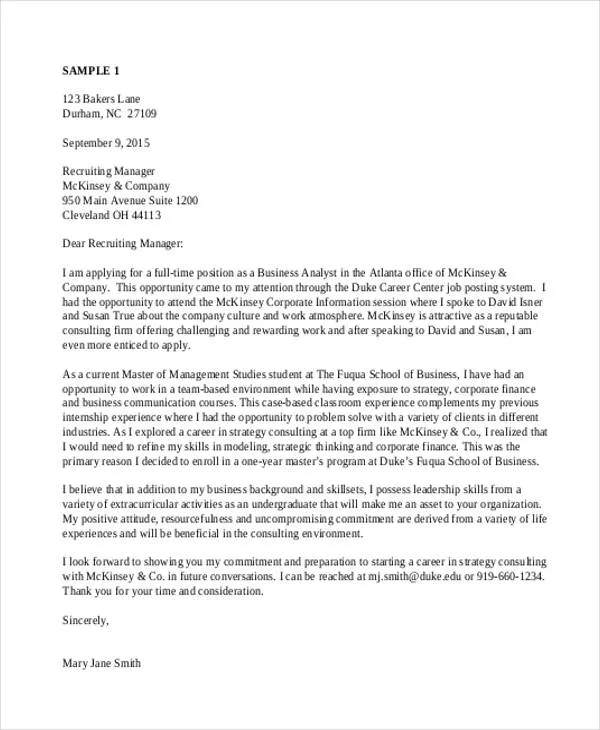Understanding the Consultant Cover Letter
A consultant cover letter is a crucial document in your job application, serving as your introduction to a potential employer. Unlike a resume, which provides a factual overview of your experience and skills, a cover letter allows you to showcase your personality, express your enthusiasm for the specific role, and demonstrate how your unique qualifications align with the company’s needs. It’s your chance to make a strong first impression and persuade the hiring manager that you’re the ideal candidate for the consulting position. A well-crafted cover letter can significantly increase your chances of getting an interview and ultimately landing the job. It acts as a bridge between your resume and the hiring manager, providing context, depth, and a personal touch that a resume alone cannot achieve.
Why a Great Consultant Cover Letter Matters
In the competitive field of consulting, where candidates often possess similar qualifications, a standout cover letter can be the deciding factor. It allows you to differentiate yourself from other applicants by highlighting your specific skills, experiences, and the unique value you bring to the table. A compelling cover letter demonstrates your understanding of the consulting role and the company’s needs, showing that you’ve done your research and are genuinely interested in the opportunity. Moreover, it allows you to address any potential gaps or concerns in your resume, providing context and explanations that can strengthen your application. A great cover letter showcases your communication skills, professionalism, and attention to detail – all essential qualities for a successful consultant. It’s your opportunity to make a memorable impression and secure an interview. A weak cover letter can be the reason that your application is rejected.
Key Components of a Consultant Cover Letter
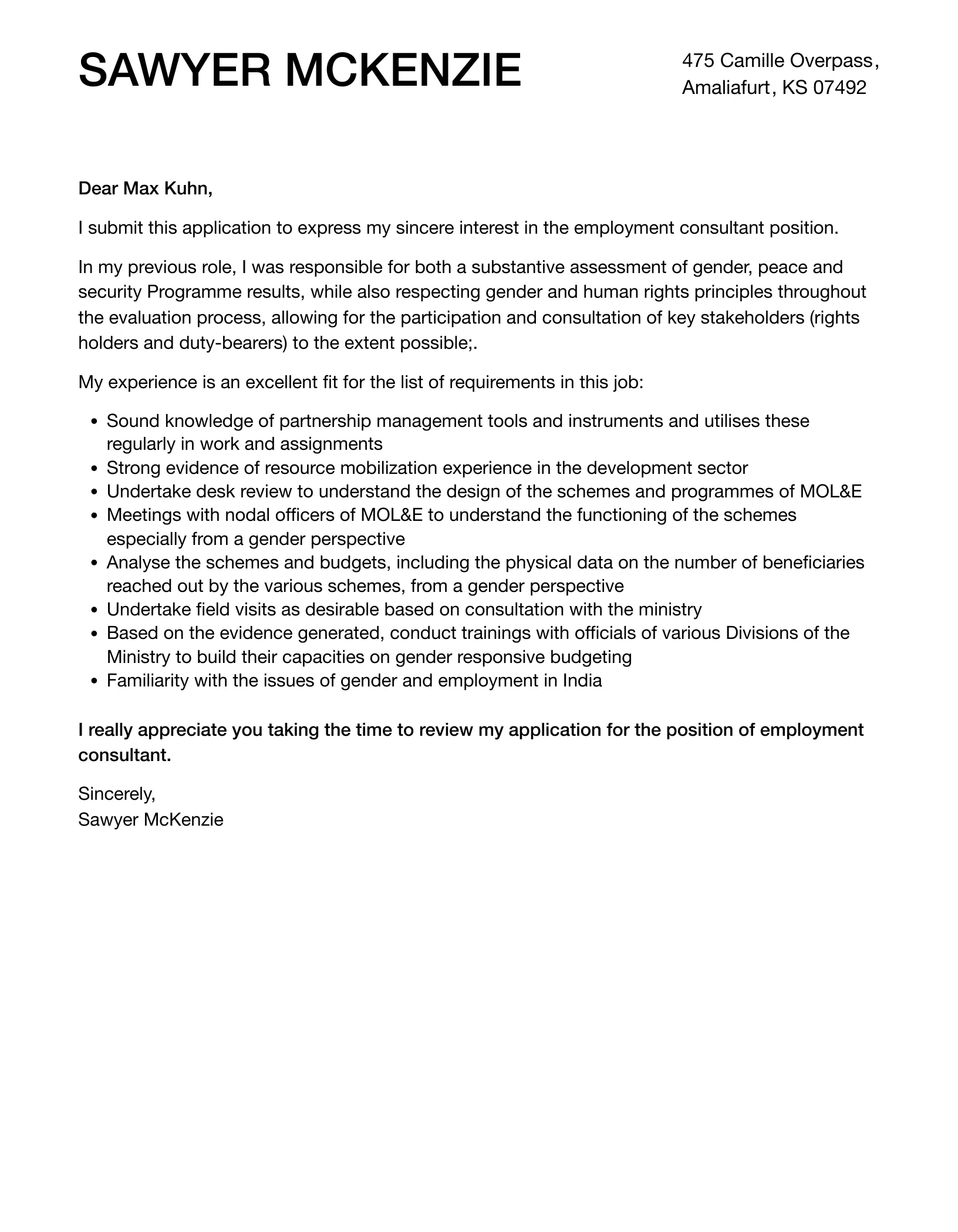
A successful consultant cover letter comprises several key components that work together to present a compelling case for your candidacy. These include your contact information and a professional salutation, an engaging opening paragraph designed to grab the reader’s attention, a section highlighting your relevant skills and experience, a section quantifying your achievements with data and metrics, an area demonstrating your understanding of the job description and tailoring your letter accordingly, a section showcasing your knowledge of the company, an expression of your enthusiasm for the role and the company, a clear call to action, and a professional closing. Each component plays a vital role in conveying your qualifications and enthusiasm. The entire letter should be concise, well-structured, and free of errors. A well-formatted cover letter is visually appealing and easy to read, reflecting your professionalism and attention to detail.
Contact Information and Salutation
Begin your cover letter with your contact information at the top, including your full name, phone number, email address, and LinkedIn profile URL. Follow this with the date and the hiring manager’s name and title, if known. If you can’t find the hiring manager’s name, use a professional salutation like “Dear Hiring Manager.” Avoid generic greetings like “To Whom It May Concern.” Addressing the letter to a specific person shows that you’ve taken the time to research the company and the role, indicating your genuine interest. Ensuring your contact information is accurate and up-to-date is essential to make it easy for the hiring manager to contact you. This professional touch sets the tone for the rest of your cover letter and demonstrates your attention to detail.
Opening Paragraph: Grab Their Attention
The opening paragraph is your chance to make a strong first impression. Start with a hook that immediately grabs the reader’s attention. You can mention a specific achievement, a skill that aligns perfectly with the job requirements, or your excitement about the company and the role. Clearly state the position you’re applying for and where you found the job posting. Avoid generic opening sentences. Instead, personalize your introduction to demonstrate your understanding of the company and the specific requirements of the role. This initial paragraph should be concise, engaging, and set the stage for the rest of your cover letter. You can also state your understanding about the company and how you think it is the right fit for you and why, this also gives a strong impression.
Highlighting Your Skills and Experience
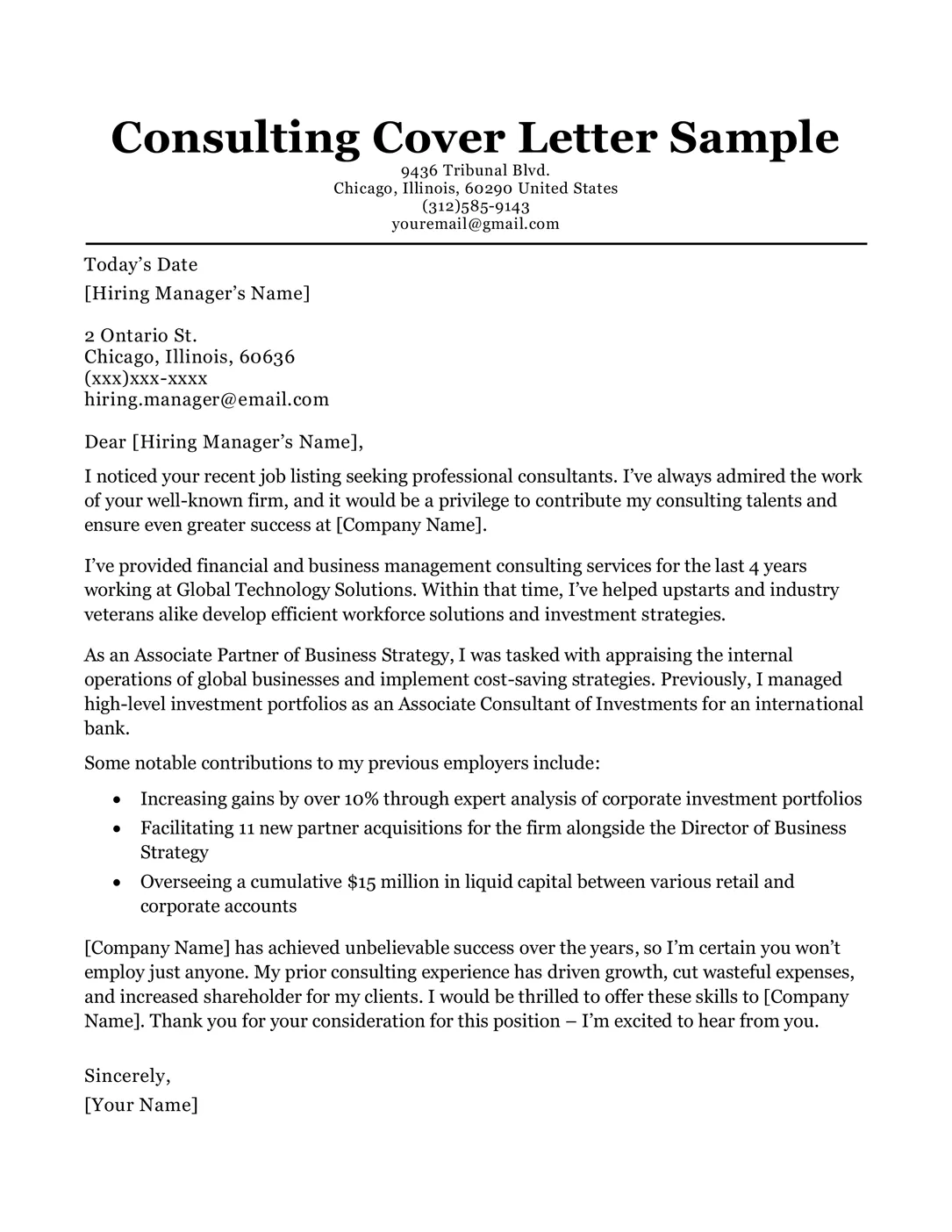
In the body of your cover letter, focus on the skills and experience that make you a strong candidate for the consulting position. Carefully review the job description and identify the key skills and qualifications the employer is seeking. Provide specific examples of how you’ve demonstrated these skills in previous roles. Use action verbs to describe your accomplishments and responsibilities, and quantify your achievements whenever possible. Highlight projects that showcase your problem-solving abilities, analytical skills, and ability to work collaboratively. Tailor this section to match the specific requirements of the job you’re applying for, ensuring that you address the key needs of the company. When showcasing your experience, consider adding how your experience relates to the needs of the company.
Quantify Your Achievements
Whenever possible, quantify your achievements with data and metrics. Instead of simply stating that you improved efficiency, provide specific numbers, such as “Increased operational efficiency by 15% within six months.” This demonstrates the tangible results you’ve achieved in past roles and provides concrete evidence of your capabilities. Using data adds credibility to your claims and showcases your ability to deliver results. Include metrics such as increased revenue, cost savings, project completion rates, or any other relevant data. This allows the hiring manager to quickly grasp the value you brought to previous employers and understand the potential impact you can have in the new role. Quantification is a powerful tool that sets you apart from other candidates who may only provide general descriptions of their experience. Don’t be afraid to put your numbers to the test and show how you did it!
Tailoring to the Job Description
Customizing your cover letter for each job application is crucial. Avoid using a generic cover letter. Take the time to carefully review the job description and identify the specific requirements, skills, and keywords the employer is looking for. Then, tailor your cover letter to address these specific needs, highlighting the relevant skills and experience that align with the role. Refer directly to the job description and use similar language to demonstrate your understanding of the requirements. This shows the hiring manager that you’ve taken the time to understand the role and are a good fit for the position. Tailoring your cover letter demonstrates your genuine interest in the job and increases your chances of getting an interview. Make it a priority to change the cover letter for each company that you send it to, it really does help!
Showcase Your Understanding of the Company
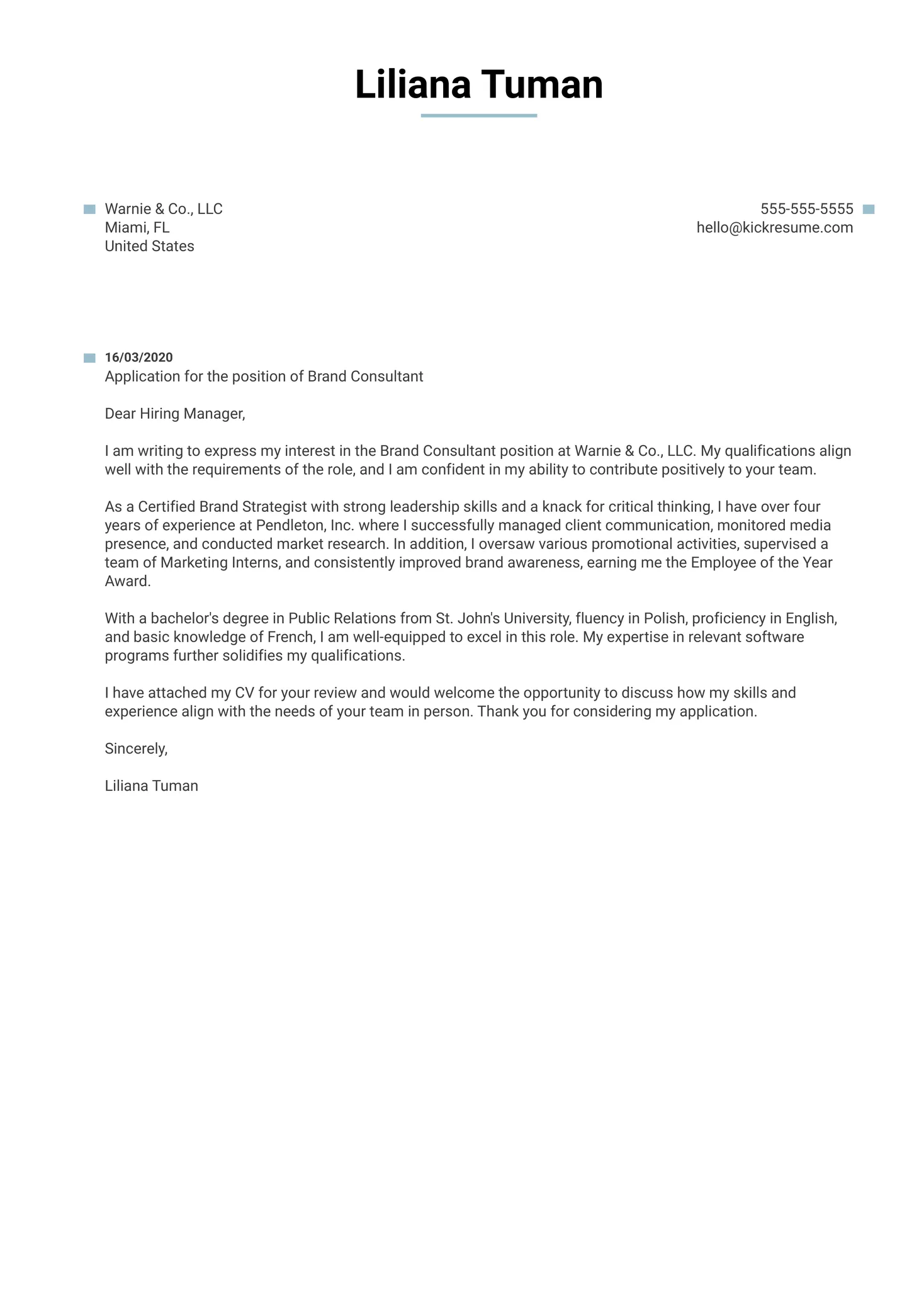
Demonstrate your knowledge of the company by conducting thorough research. Visit the company’s website, read their mission statement, and review their recent news and press releases. Understand their products, services, clients, and values. In your cover letter, mention specific projects, initiatives, or accomplishments that align with the company’s goals. This shows that you’re genuinely interested in working for them and understand their business. Showing that you understand the company also helps you stand out, it is important that you are not just sending a cover letter but also doing your research. This preparation demonstrates initiative and a proactive approach, which are highly valued in a consultant. A well-researched cover letter demonstrates that you are not just applying for a job, but that you have a clear understanding of the company’s needs and how you can contribute to their success.
Expressing Enthusiasm and Professionalism
Throughout your cover letter, express your enthusiasm for the role and the company. Use positive and confident language to convey your excitement about the opportunity. Show your passion for consulting and your desire to contribute to the company’s success. Maintain a professional tone and avoid overly casual or informal language. Proofread your cover letter carefully to ensure that it is free of errors and reflects your attention to detail. Use clear and concise language to communicate your ideas effectively. Demonstrate your understanding of the consulting role and your commitment to delivering high-quality results. Emphasize your transferable skills. Your enthusiasm can be a very important factor in landing the job, make it easy for them to see why you like their company.
Call to Action and Closing
In your closing paragraph, include a clear call to action. State your desire to discuss your qualifications further and express your availability for an interview. Thank the hiring manager for their time and consideration. Reiterate your interest in the role and express your enthusiasm for the opportunity. End with a professional closing such as “Sincerely” or “Best regards,” followed by your full name. Ensure that your contact information is easily accessible. A well-crafted closing paragraph reinforces your interest and leaves a positive final impression on the hiring manager. A strong call to action encourages the hiring manager to take the next step and schedule an interview.
Proofreading and Formatting Your Cover Letter
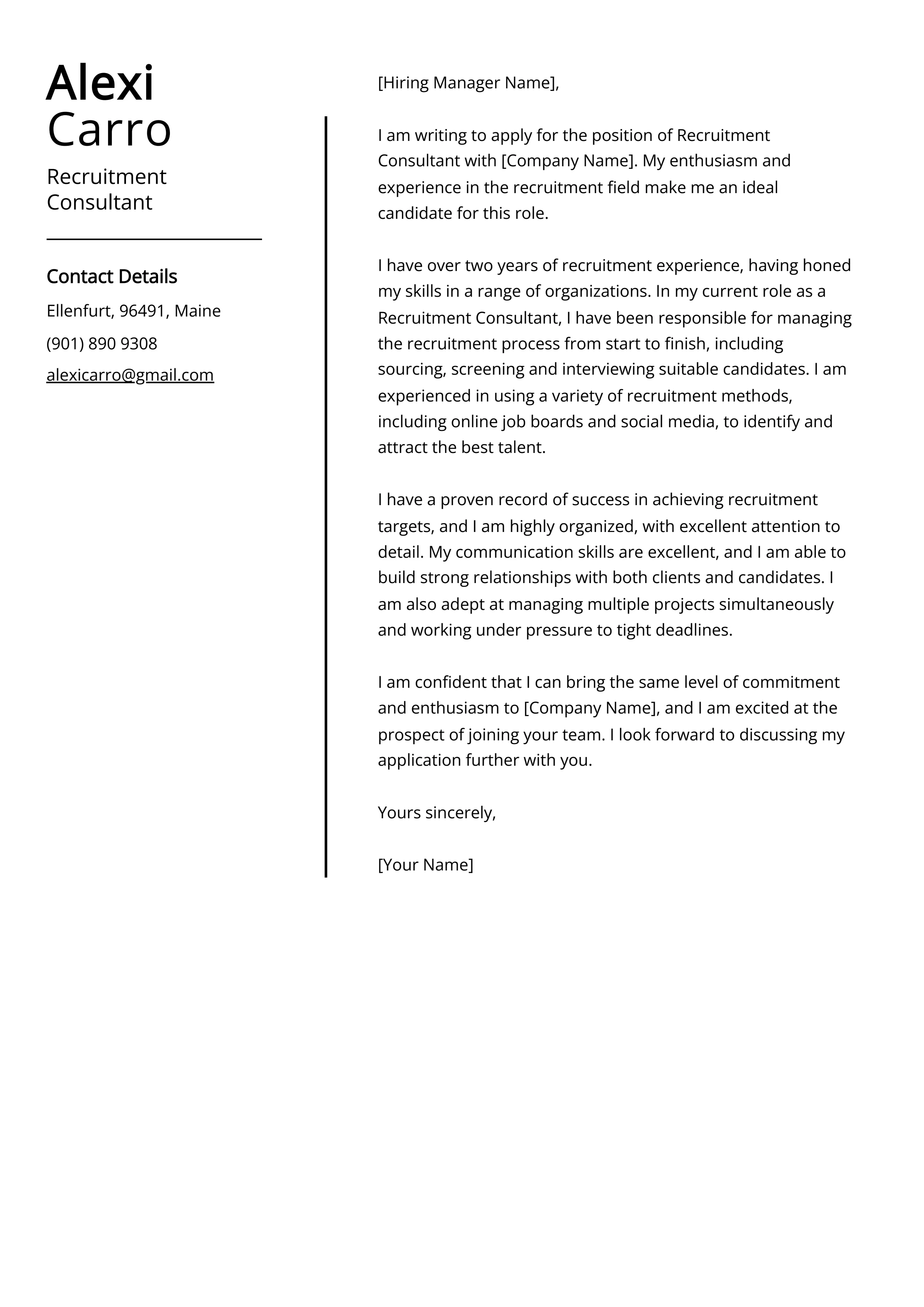
Before submitting your cover letter, proofread it carefully to eliminate any errors in grammar, spelling, and punctuation. Typos and grammatical errors can undermine your professionalism and credibility. Ensure that your cover letter is well-formatted, easy to read, and visually appealing. Use a clear and professional font, such as Times New Roman, Arial, or Calibri, with a font size of 11 or 12 points. Use consistent formatting throughout your letter, including spacing, margins, and bullet points. Proofread the document multiple times, or ask a friend, family member, or career advisor to review it. Correct formatting and attention to detail demonstrate your professionalism and commitment to delivering high-quality work. Double-check everything, and you can be sure that you will make a great impression.
Common Mistakes to Avoid
Avoid common mistakes that can damage your chances of getting hired. Don’t use generic or overly generic cover letters. Don’t provide inaccurate or misleading information. Avoid typos, grammatical errors, and formatting inconsistencies. Don’t use overly casual or informal language. Do not exceed one page in length. Avoid negative language or complaining about previous employers. Refrain from repeating information that is already in your resume, instead, use the opportunity to provide context. Focus on what you can offer the company, rather than what you are looking for. Always customize your cover letter to match the job description and the company’s needs. By avoiding these common pitfalls, you can significantly increase the effectiveness of your consultant cover letter and enhance your chances of securing an interview and ultimately, the job. Always make it personal and tailor it to the job you are applying for.
